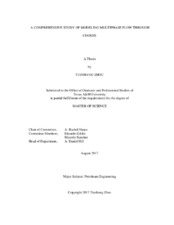| dc.description.abstract | Choke is an essential device that controls flow rates at either subsurface or surface. Many models and correlations have appeared for handling multiphase flow through surface chokes. However, direct comparison of their relative performances hasn’t been studied before, it is difficult to choose the right model or correlation for rate calculation. This thesis has evaluated and studied several models and correlations to explore their relative merits and ease of use in field settings. Seven different data sets gathered from laboratory and field, involving 1,004 independent data points, constituted the essence of this study. As expected, models anchored in thermodynamic principles outperformed others.
The performance of the slippage effect was also studied. Seven slip equations were studied to determine which slip correlation showed best performance. The study found the constants proposed by Simpson et al. used in Grolmes and Leung equation showed best performance for flow through chokes.
The study also found the importance of PVT data in flow through choke calculations. Specifically, changes in density and heat capacity with pressure and temperature should be part of any rigorous effort for flow rates computation. The rate-dependent choke discharge coefficient approach, generated from field data, outperforms the fixed discharge coefficient concept of existing models.
Based on the results, the Sachdeva and Brill model performed consistently well among those considered models. Two different approaches of modifications were offered: first, replace the specific-heat capacity ratio k by polytropic-gas-expansion coefficient n. With the optimized discharge coefficient, the accuracy was not changed much but this modification was recommended from the theoretical aspect. Second, introduce a slippage factor. However, the results showed that slippage played a minor role in estimating flow rate. This conclusion was also supported by slip velocity and flow pattern calculated. The Sachdeva and Brill model without slippage factor turned out to outperform others.
Among the correlations studied, the Fortunati correlation showed best performance but still not as good as all other models. This correlation also distinguishes flow boundary and flow type, which is an issue for the application of Al-Attar and B-K correlation. The Ashford and Pierce correlation, originally developed for subcritical flow, handles choke size up to 20/64 in. Increasing choke size requires adjustment of the choke discharge coefficient, which leads to unreliable solutions. For B-K correlation and Al-Attar critical correlation, they both use empirical coefficients derived from a particular field, which makes the correlation unreliable for other applications. Both correlations show huge errors, and B-K correlation mainly overestimates results. | en |


